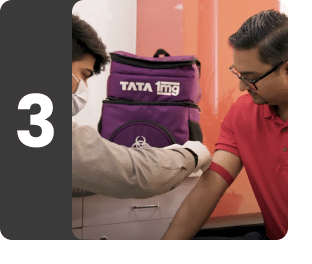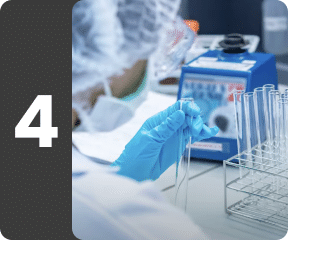Hypertension Panel
Understanding Hypertension Panel
What is Hypertension Panel?
Hypertension (high blood pressure) is one of the leading causes of death worldwide. Hypertension panel comprises of several tests to check the level of lipids, creatinine, electrolytes and glucose in the blood as their irregular levels increases the risk of hypertension. The package can be ordered as a part of routine investigation to screen hypertension. The tests are also useful for the high risk patients already suffering from diabetes, dyslipidemia, and heart disease to detect the presence of hypertension.
Early detection and treatment of hypertension is crucial to prevent any long term complications such as angina, heart attack and stroke.
What is Hypertension Panel used for?
- As a part of complete health check up or package
- If you are already diagnosed with heart disease
- It should be done every six months if you have risk factors for heart diseases like cigarette smoking, hypertension, diabetes, family history of heart disease
- Even if you don't have risk factors for heart disease, get this test done every four to six years
- The American Academy of Pediatrics also recommend that lipid profile must be done once between the ages of 9 to 11 years and again between 17 to 21 years of age
- It is done routinely to evaluate the effectiveness of lipid lowering medicines
What does Hypertension Panel measure?
Contains 12 tests
Serum Electrolyte
The serum electrolyte test measures the following electrolytes:
Sodium (Na+)
Potassium (K+)
Chloride (Cl-)
Electrolytes play an important role in a number of body functions like metabolism, neuromuscular functioning, maintaining hydration and pH (acid-base balance). Electrolytes also help in the entry of nutrients into the cells and removal of waste products from the cells. Electrolytes carry an electrical charge, either negative or positive and exist as dissolved salts in blood and body tissues. The Serum Electrolyte test measures the following important electrolytes:
Sodium (Na+)
Sodium is an essential body electrolyte which, along with potassium, chloride, bicarbonate, etc., helps to maintain the normal fluid and pH balance of the body. It is also vital for cellular metabolism, and in the activity of nerves and muscles and transmission of impulses between them. Sodium is present in all the body fluids. The highest concentration of sodium is found in blood and extracellular fluid.
Sodium is supplied to the body principally through dietary salt (sodium chloride or NaCl), and a small portion of sodium is absorbed through other food items. The required portion is absorbed by the body and the remaining is excreted by the kidneys through urine. The body maintains a very narrow range of sodium concentration by three mechanisms:
· Secretion of hormones natriuretic peptides and aldosterone to control sodium elimination through urine
· Secretion of antidiuretic hormone (ADH), also called Vasopressin, to control the volume of water eliminated through urine
· Induction of thirst
Any disruption in the above mentioned mechanisms gives rise to an imbalance in the concentration of sodium in the blood to produce Hyponatremia (low blood sodium concentration), or Hypernatremia (high blood sodium concentration). Both these conditions produce a number of symptoms and may even lead to death.
Potassium (K+)
Potassium is one of the essential body electrolytes along with sodium, chloride, bicarbonate, etc. As an electrolyte, potassium helps to regulate the amount of fluids present in the body and to maintain a correct pH balance. It performs a vital role in cellular metabolism and transport of nutrients and waste products in and out of cells. It is also essential in the transmission of nerve impulses to muscles and muscle activity.
Sufficient amount of potassium required by the body is absorbed from dietary sources, and the remaining unabsorbed potassium is excreted by the kidneys. The hormone called aldosterone maintains the body potassium level within a small normal range. Aldosterone acts on the nephrons present in the kidneys and activates a sodium-potassium pump which helps the body to reabsorb sodium and excrete potassium. This helps to maintain the potassium concentration in the blood within its normal range. Deviation of potassium concentration from its normal range gives rise to Hyperkalemia (high potassium level in blood), or Hypokalemia (low potassium level in blood). Both these conditions may produce a number of symptoms, and may even be fatal if not controlled.
Chloride (Cl-)
Chloride is an essential mineral which acts as an electrolyte along with potassium, sodium, bicarbonate, etc. It helps to maintain the normal fluid and electrolyte balance in the body. It also acts as a buffer to help maintain the pH balance of the body. It also plays essential roles in metabolism. Chloride is used by the stomach to produce hydrochloric acid (HCl) for digestion. Chloride is present in every body fluid. The highest concentration of chloride is found in blood and extracellular fluid (fluid present outside the cells).
Most of the chloride is supplied to the body through dietary salt (sodium chloride or NaCl), and a small portion is absorbed through other food items. The required portion is absorbed by the body and the remaining is excreted by the kidneys through urine. The concentration of chloride in blood is maintained within a very narrow range by the body. Its increase or decrease is directly correlated with the sodium levels.
Know more about Serum Electrolyte
This further contains
- Potassium
- Chloride
- Sodium

Cholesterol - Total
Cholesterol is essential for life, as it is required by the body to work properly. It plays a role in the formation of cell membranes in all organs and tissues in the body. It is associated with the formation of hormones which are important for development, growth, and reproduction. It forms bile acids, which help to absorb nutrients from food.
In the blood, a small amount of cholesterol circulates in the form of lipoproteins which contains protein, cholesterol, triglyceride, and phospholipid molecules. These are classified according to their density into HDL (high-density lipoproteins), LDL (low-density lipoproteins), and VLDL (very low-density lipoproteins). HDL cholesterol is also known as good cholesterol, as it carries excess cholesterol away for disposal while LDL cholesterol is also known as bad cholesterol, as it deposits cholesterol in tissues and organs.
It is important to maintain and monitor the levels of cholesterol for a healthy lifestyle. The source of cholesterol is diet as well. If a person is taking too much of cholesterol-rich foods, it can cause a rise in levels of cholesterol in the blood. The amount of cholesterol which is not required by the body starts to deposit in the form of plaques on the walls of blood vessels. These plaques can narrow or block the blood vessels opening which can lead to the hardening of arteries known as atherosclerosis. Also, with an increase in cholesterol levels, there is an increased risk of various conditions such as heart disease and stroke.
Know more about Cholesterol - Total

Creatinine
Creatinine is a waste product which is produced by the muscles due to the breakdown of a compound called Creatine. During the cycle of energy production which is required to contract muscles, creatine is produced. Kidneys remove creatinine from the body by filtering it from the blood and then releasing it into the urine. This test measures the amount of creatinine in the blood.
The body produces creatine and creatinine at a relatively same rate. Since kidneys filter most of the creatinine from the blood and release it into the urine, the blood levels can be used as an indicator to know how well the kidneys are functioning. The amount of creatinine produced depends upon the size of the person as well as their muscle mass. That is why levels of creatinine are higher in men as compared to women and children.
Know more about Creatinine
Cholesterol - HDL

Triglycerides
Triglycerides test measures the levels of triglycerides in the blood.
Triglycerides are a type of body fat (lipid). Chemically, triglycerides consist of three ("tri-") molecules of fatty acid combined with a molecule of the alcohol glycerol ("-glyceride").
High levels of triglycerides in the blood have been linked to atherosclerosis which increases the risk of heart disease (Coronary Artery Disease), peripheral artery disease, stroke and kidney disease. Atherosclerosis is a disease in which plaque (made up of fat, cholesterol, calcium, and other substances) builds up inside the arteries (blood vessels) resulting in narrowing of the lumen. This restricts the flow of blood to the organs and other parts of the body. Signs and symptoms of atherosclerosis usually do not appear until severe or total blockage of the artery (blood vessel). Therefore, most people are not aware of atherosclerosis until they have a medical emergency, such as a heart attack or stroke.
Increased levels of triglycerides may also be seen in Metabolic syndrome (cluster of metabolic risk factors for cardiovascular disease, type 2 diabetes and stroke). Very high triglyceride levels can also cause inflammation of the pancreas (pancreatitis).
Triglycerides test is usually done as a part of lipid profile which includes other tests like cholesterol, HDL (High-density lipoprotein), LDL (Low-density lipoprotein), VLDL (Very low-density lipoprotein) also.
Know more about Triglycerides

Blood Urea
Urea is a byproduct of protein metabolism. Proteins consumed in the diet are digested and converted into amino acids, which are utilized by the body. This metabolic process creates toxic byproduct ammonia. This byproduct is rapidly converted by the liver to form urea, which is less toxic and is transported relatively safely in blood. Following this, urea is transported by the blood to the kidneys. The kidneys then filter it out of the blood and excrete it out of the body in a solution called urine. This process continues and the body keeps producing and excreting urea, hence maintaining a low and steady level of urea in the blood.
The BUN test measures the amount of urea present in the urea. The levels of BUN test in the blood are affected due to impairment of kidney function, or due to large scale liver conditions. Primarily, BUN Test results are used to evaluate kidney functioning. Results are often interpreted together with results of Creatinine Tests that measure the levels of another metabolic waste (creatinine), which is also excreted in the urine.
Know more about Blood Urea

Cholesterol - LDL
The cholesterol LDL test measures the levels of cholesterol LDL in the blood. LDL also known as low-density lipoprotein carries cholesterol in the blood. It consists mainly of cholesterol, similar other substances, and a small amount of protein.
It is very important to monitor and maintain healthy levels of lipids for staying healthy. Intake of foods that are high in saturated fats and trans unsaturated fats can raise the levels of cholesterol in the blood. The extra cholesterol gets deposited in plaques on the walls of blood vessels. This may result in atherosclerosis (hardening of the arteries). It can also increase the risk of various other health problems such as heart disease and stroke.
The cholesterol LDL is known as “bad cholesterol” as it gets deposited in the vessels as plaque, giving rise to cardiovascular diseases. The cholesterol HDL which is the high-density lipoproteins cholesterol is known as “good cholesterol” as its role is to transport cholesterol from the arteries to the liver and thus protects the body against heart diseases.
The cholesterol LDL test helps in determining the risk of heart disease in an individual. It also helps in planning out the treatment considering other known risk factors as well. The treatment can involve changes in lifestyle such as diet and exercise or lipid-lowering medications such as statins.
Know more about Cholesterol - LDL
Very Low Density Lipoprotein

Glucose - Fasting
Glucose - Fasting Blood Test is done to measure the levels of glucose in blood during period of fasting.
Glucose is the main source of energy for body. Carbohydrates consumed in the diet are broken down in the body to glucose, which is absorbed by the intestines and transported by the blood to various organs. The cells of these organs utilize the glucose to produce energy when required, and the excess is stored either as glycogen in the liver for short-term storage or in fat tissues as triglycerides for long-term storage. The uptake, utilization, and storage of glucose after it is absorbed in the intestines is facilitated by the hormone- insulin which is secreted by the pancreas. Insulin influences the transport of glucose to the organs like heart, brain, working muscles, etc. It also directs storage of excess glucose. The action of insulin reduces sugar levels in the blood.
After a meal, sugar levels increase in blood and insulin is secreted in response to reduce sugar levels until it becomes normal. If glucose levels fall too low in blood, another pancreatic hormone called glucagon is released, which directs the liver to convert stored glycogen into glucose and releases it into the blood. The insulin and glucagon hormones create a feedback mechanism to keep blood glucose levels within the normal range. Imbalance in their activity causes an excess or shortage of blood sugar.
Glucose - Fasting blood Test helps to determine if the body is able to utilize or store glucose efficiently. High levels of sugar in blood indicates diabetes or resistance to insulin. Type 1 Diabetes is caused when insulin is not produced or produced in very little quantity. Type 2 Diabetes is caused when insulin produced is not utilized effectively by the body. In both these cases, blood sugar level rises, while cells are deprived of nutrition.
Know more about Glucose - Fasting
Non HDL Cholesterol
Frequently Asked Questions about Hypertension Panel
Q. Is there any risk associated with this test?
Book a Hypertension Panel test at home near me





Other tests








